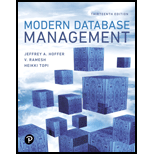
Concept explainers
Definitions of the following terms:
a. Application partitioning
b. Application
c. Client/server system
d. Middleware
e. Three-tier architecture
f. locking
g. versioning
h. deadlock
Explanation of Solution
Application partitioning
The method of assigning components of application software, after it is written, to client or server partitions in order to gain increased performance and interoperability is termed as application partitioning. Here, interoperability refers to ability to function on different platforms.
Application programming interface (API)
An API is a set of routines, protocols and tools that are used by an application program to interact with other software applications. APIs are used for software development and in context to
Client/server system
It is a networked computing model in which processes are distributed between clients and servers, which provide the needed services. Generally heavy processing applications are stored on the server and light application reside on a client. Client continuously interacts with the server to perform certain tasks. In context of a database system, the database along with the DBMS generally resides on a server and server is responsible for processing the DBMS. End user application system resides on the client which requests services from the client.
Middleware
Middlewares are softwares which act as a bridge between application and
Three-tier architecture
It is a three-layer client/server configuration where one client layer and two server layers are present. This architecture contains one additional server layer as compared to two-tier client/server architecture.
Locking
It is a
Versioning
It is an approach for concurrency control during which each transaction under execution is limited to a portion of the database during its execution period, and when a transaction tries to modify a record, new record version for it is created instead of overwriting the old record.
Deadlock
It is a situation in which no progress can be made during transaction processing. It occurs when two or more transactions have acquired some common limited resources.
Want to see more full solutions like this?
Chapter 7 Solutions
Modern Database Management
- Solve this "Do not use AI tools. Solve the problem by hand on paper only and upload a photo of your handwritten solution."arrow_forwardSolve this "Do not use AI tools. Solve the problem by hand on paper only and upload a photo of your handwritten solution."arrow_forwardSolve this "Do not use AI tools. Solve the problem by hand on paper only and upload a photo of your handwritten solution."arrow_forward
- Solve this "Do not use AI tools. Solve the problem by hand on paper only and upload a photo of your handwritten solution."arrow_forwardSolve this "Do not use AI tools. Solve the problem by hand on paper only and upload a photo of your handwritten solution."arrow_forwardIn three years, assuming the competitive environment remains unchanged, how many units of Bat will Baldwin be selling in the Nano market segment? a) 639 b) 561 c) 431 d) 716arrow_forward
- Brand managers know that increasing promotional budgets eventually result in diminishing returns. The first one million dollars typically results in a 26% increase in awareness, while the second million results in adding another 18% and the third million in a 5% increase. Andrews’s product Alan currently has an awareness level of 80% . While an important product for Andrews, Alan’s promotion budget will be reduced to one million dollars for the upcoming year. Assuming that Alan loses one-third of its awareness each year, what will Alan’s awareness level be next year? a) 79% b) 53% c) 74% d) 58%arrow_forwardDo not use A.I and solve completelyarrow_forwardSolve thisarrow_forward
- Specifications: Part-1Part-1: DescriptionIn this part of the lab you will build a single operation ALU. This ALU will implement a bitwise left rotation. Forthis lab assignment you are not allowed to use Digital's Arithmetic components.IF YOU ARE FOUND USING THEM, YOU WILL RECEIVE A ZERO FOR LAB2!The ALU you will be implementing consists of two 4-bit inputs (named inA and inB) and one 4-bit output (named out). Your ALU must rotate the bits in inA by the amount given by inB (i.e. 0-15).Part-1: User InterfaceYou are provided an interface file lab2_part1.dig; start Part-1 from this file.NOTE: You are not permitted to edit the content inside the dotted lines rectangle.Part-1: ExampleIn the figure above, the input values that we have selected to test are inA = {inA_3, inA_2, inA_1, inA_0} = {0, 1, 0,0} and inB = {inB_3, inB_2, inB_1, inB_0} = {0, 0, 1, 0}. Therefore, we must rotate the bus 0100 bitwise left by00102, or 2 in base 10, to get {0, 0, 0, 1}. Please note that a rotation left is…arrow_forwardHow can I perform Laplace Transformation when using integration based on this? Where we convert time-based domain to frequency domainarrow_forwardwhat would be the best way I can explain the bevhoirs of Laplace and Inverse Transofrmation In MATLAB.arrow_forward
 Systems ArchitectureComputer ScienceISBN:9781305080195Author:Stephen D. BurdPublisher:Cengage Learning
Systems ArchitectureComputer ScienceISBN:9781305080195Author:Stephen D. BurdPublisher:Cengage Learning Principles of Information Systems (MindTap Course...Computer ScienceISBN:9781285867168Author:Ralph Stair, George ReynoldsPublisher:Cengage Learning
Principles of Information Systems (MindTap Course...Computer ScienceISBN:9781285867168Author:Ralph Stair, George ReynoldsPublisher:Cengage Learning Management Of Information SecurityComputer ScienceISBN:9781337405713Author:WHITMAN, Michael.Publisher:Cengage Learning,
Management Of Information SecurityComputer ScienceISBN:9781337405713Author:WHITMAN, Michael.Publisher:Cengage Learning, Enhanced Discovering Computers 2017 (Shelly Cashm...Computer ScienceISBN:9781305657458Author:Misty E. Vermaat, Susan L. Sebok, Steven M. Freund, Mark Frydenberg, Jennifer T. CampbellPublisher:Cengage Learning
Enhanced Discovering Computers 2017 (Shelly Cashm...Computer ScienceISBN:9781305657458Author:Misty E. Vermaat, Susan L. Sebok, Steven M. Freund, Mark Frydenberg, Jennifer T. CampbellPublisher:Cengage Learning Principles of Information Systems (MindTap Course...Computer ScienceISBN:9781305971776Author:Ralph Stair, George ReynoldsPublisher:Cengage Learning
Principles of Information Systems (MindTap Course...Computer ScienceISBN:9781305971776Author:Ralph Stair, George ReynoldsPublisher:Cengage Learning





